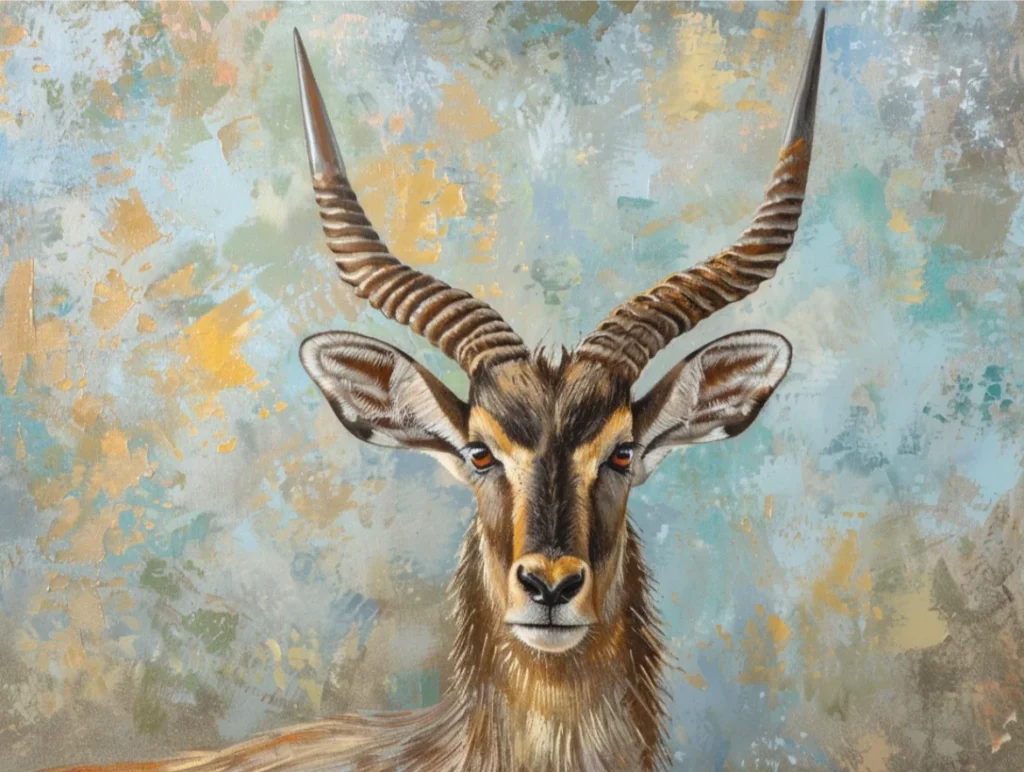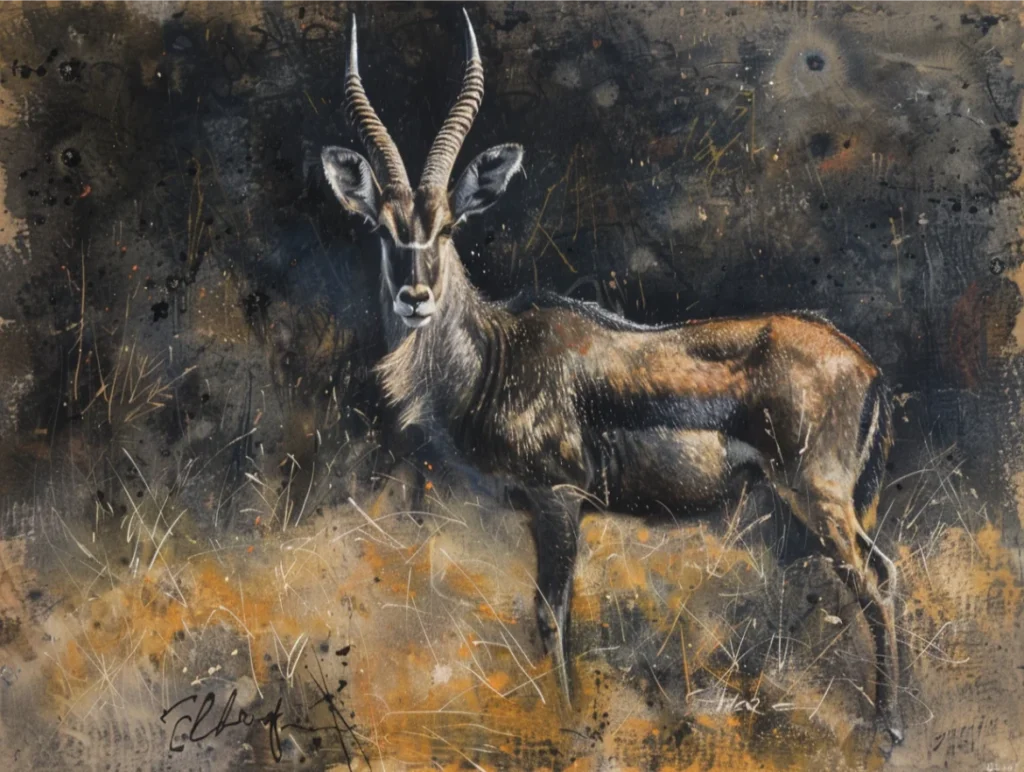Waterbuck Symbolism and Meaning: Uncovering the Secrets of this Majestic Antelope

Have you ever encountered a waterbuck in the wild or in captivity and wondered about the deeper meaning behind this magnificent creature? Waterbucks are not only stunning animals but also carry rich symbolism and significance in various cultures and traditions. In this comprehensive guide, we’ll dive into the captivating world of waterbuck symbolism and meaning, exploring the many ways this antelope has inspired and influenced human beliefs and practices.
What is a Waterbuck?

Before we delve into the symbolic aspects of the waterbuck, let’s take a moment to familiarize ourselves with this remarkable animal:
- Waterbucks are large, robust antelopes native to sub-Saharan Africa.
- They are known for their distinctive white ring around their rump and their shaggy, reddish-brown coat.
- As their name suggests, waterbucks have a strong affinity for water and are often found near rivers, lakes, and wetlands.
- Males, called bulls, have impressive spiral horns that can grow up to 40 inches long.
Now that we have a basic understanding of the waterbuck’s physical characteristics and habitat, let’s explore the rich symbolism and meaning associated with this majestic creature.
Waterbuck as a Symbol of Strength and Resilience

One of the most prominent symbolic meanings attributed to the waterbuck is strength and resilience. These antelopes are known for their ability to thrive in challenging environments and overcome obstacles with grace and determination. Here are some ways in which the waterbuck embodies these qualities:
- Adaptability: Waterbucks are highly adaptable animals, capable of living in a variety of habitats, from savannas to forests. They can endure harsh conditions and find sustenance even in times of scarcity. This adaptability is a powerful symbol of resilience and the ability to overcome adversity.
- Endurance: With their muscular build and strong legs, waterbucks are built for endurance. They can run at high speeds for extended periods and navigate rough terrain with ease. This physical endurance translates into a symbolic representation of mental and emotional stamina, reminding us to persevere through life’s challenges.
- Protective Instincts: Waterbucks, particularly the males, are known for their protective nature. They fiercely defend their territories and herds from predators and rivals. This protective instinct symbolizes the importance of standing up for oneself and one’s loved ones, even in the face of danger.
Waterbuck and the Element of Water

As their name implies, waterbucks have a deep connection to the element of water. In many cultures, water is associated with emotions, intuition, and the subconscious mind. The waterbuck’s affinity for water carries several symbolic meanings:
- Emotional Healing: Just as water has the power to cleanse and purify, the waterbuck’s connection to water symbolizes emotional healing and renewal. It reminds us to acknowledge and process our emotions, allowing them to flow freely rather than bottling them up.
- Intuition and Insight: Waterbucks are often seen standing still near water sources, seemingly lost in contemplation. This behavior has come to symbolize the importance of listening to our intuition and seeking insight from within. By taking moments of quiet reflection, we can tap into our inner wisdom and make better decisions.
- Fluidity and Adaptability: Water is a fluid and adaptable element, capable of taking on various forms and navigating through obstacles. The waterbuck’s relationship with water symbolizes the importance of being flexible and adaptable in life, allowing ourselves to flow with the current rather than resisting change.
Waterbuck in African Folklore and Mythology

In many African cultures, the waterbuck holds a special place in folklore and mythology. These stories often revolve around the animal’s beauty, grace, and spiritual significance. Here are a few examples:
- Zulu Folklore: In Zulu folklore, the waterbuck is associated with the god of rain, Unkulunkulu. It is believed that when a waterbuck is seen near a river or lake, it is a sign that Unkulunkulu is pleased and will bless the land with abundant rainfall.
- Maasai Mythology: The Maasai people of East Africa have a creation myth involving the waterbuck. According to the story, the first waterbuck emerged from a pool of water, created by the god Enkai. The waterbuck’s appearance signified the beginning of life on Earth and the arrival of other animals.
- Pygmy Legends: In some Pygmy cultures of Central Africa, the waterbuck is considered a sacred animal. It is believed that the waterbuck possesses spiritual powers and can communicate with the spirit world. Pygmy shamans often seek guidance from the waterbuck during rituals and healing ceremonies.
These mythological and folkloric tales highlight the waterbuck’s spiritual significance and its role as a messenger between the human and divine realms.
Waterbuck as a Totem Animal
In many African traditions, animals are believed to serve as spiritual guides or totems, offering wisdom, protection, and inspiration to those who identify with them. If the waterbuck is your totem animal, it may indicate that you possess the following qualities:
- Strength and Resilience: Like the waterbuck, you have the inner strength to overcome challenges and thrive in difficult circumstances. You are adaptable and capable of finding solutions to problems that may seem insurmountable to others.
- Emotional Intelligence: The waterbuck’s connection to water suggests a deep emotional intelligence. You are attuned to your own emotions and the emotions of others, making you a compassionate and understanding individual.
- Protective Instincts: If the waterbuck is your totem, you may have a strong desire to protect and defend those you care about. You are willing to stand up for what you believe in and fight for the well-being of your loved ones.
- Intuitive Wisdom: The waterbuck’s contemplative nature indicates a connection to intuition and inner wisdom. You have the ability to listen to your gut instincts and make decisions based on a deep understanding of yourself and the world around you.
Embracing the waterbuck as your totem animal can help you harness these qualities and navigate life’s challenges with grace, strength, and wisdom.
Waterbuck in Art and Popular Culture
The waterbuck’s beauty and symbolic significance have inspired artists and creators across various mediums. From traditional African art to contemporary works, the waterbuck has been depicted in a range of styles and contexts. Here are a few examples:
- African Masks: In some African cultures, waterbuck-inspired masks are used in religious ceremonies and rituals. These masks often feature the animal’s distinctive horns and are believed to channel the waterbuck’s spiritual energy.
- Paintings and Sculptures: Many artists have been drawn to the waterbuck’s graceful form and have incorporated it into their works. From realistic depictions to abstract interpretations, the waterbuck has been a subject of fascination for painters and sculptors alike.
- Photography: Wildlife photographers have captured stunning images of waterbucks in their natural habitats, showcasing their beauty and majesty. These photographs not only document the animal’s physical appearance but also evoke a sense of its symbolic power.
- Film and Television: While not as prevalent as some other African animals, waterbucks have made appearances in documentaries and nature programs, educating audiences about their behavior and ecological importance.
The presence of waterbucks in art and popular culture serves as a testament to their enduring symbolic significance and the ways in which they continue to inspire and captivate the human imagination.
Conclusion
From its physical strength and resilience to its deep connection with water and spiritual symbolism, the waterbuck is a truly remarkable animal that has left an indelible mark on human culture and consciousness. By understanding and appreciating the rich symbolism and meaning associated with this majestic antelope, we can gain valuable insights into our own lives and the world around us.
Whether you encounter a waterbuck in the wild, in captivity, or through artistic and cultural representations, take a moment to reflect on the profound lessons it has to offer. Embrace your own strength, adaptability, and intuitive wisdom, and let the waterbuck’s spirit guide you on your journey through life.
As we continue to explore and appreciate the natural world, let us remember the waterbuck and the countless other creatures that enrich our lives with their beauty, symbolism, and enduring presence. By honoring their significance and learning from their example, we can forge a deeper connection with the earth and all its inhabitants, creating a more harmonious and meaningful existence for ourselves and future generations.





